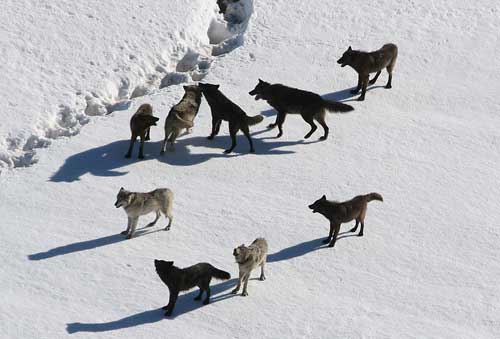Collective nouns also present challenges in subject-verb agreement. A collective noun names a group of people or things. Examples of collective nouns you often hear in school are class, committee, team, audience, and club.
Watch this video to learn more collective nouns.
Circling back to the previous section and the German Shepherds, which would gather in packs, we’re reminded that not all animals congregate in such humdrum collective nouns. What about a peep of chickens, a shrewdness of apes, an obstinacy of buffalo, a murder of crows, or a pandemonium of parrots? Maybe you know some others, but we’ll limit ourselves to these examples. Here are some tips to make working with collective nouns less tricky:

Source: Yellowstone Wolves, Doug Smith, Wikimedia
- When the members of the group are acting in unison, the verb is singular.
The pack of wolves plays happily.
- Don’t be thrown off by the plural in the prepositional phrase “of wolves.” Pack is the subject of the sentence. When the members of the pack are acting as individuals, the verb is plural.
The pack of wolves drinks from several creeks.
The sentence above suggests that the wolves are drinking individually (i.e., each one drinking separately) and are not acting in unison.
- When you’re writing about people, the word members is handy.
The members of the team turned in their pompoms.
- Intervening words, such as clauses and phrases, which sit between the subject and the verb, also confuse subject-verb agreement. When you come across a sentence that has a lot of information separating the subject and the verb, don’t be misled. You can temporarily cross out the intervening words to see if the subject and verb agree in number. Once the subject and verb are in close proximity, your “grammar phone” will tell you if they agree.
The wolfwhich had been running away from the huntersstood still.
The packof wolvesstands tall.
For a good review of subject-verb agreement, watch this video.